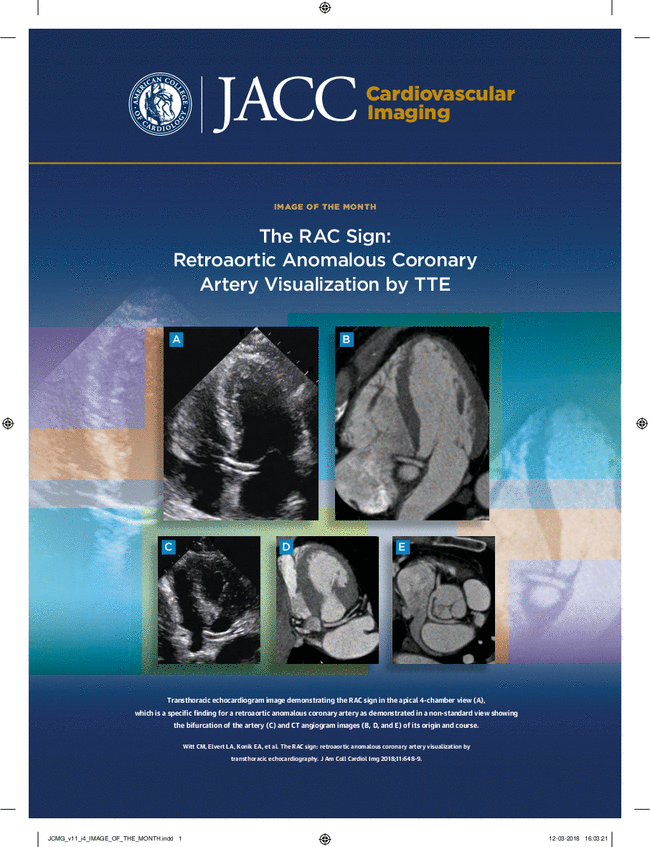无症状主动脉瓣反流早期左心室功能障碍的超声心动图标记:是改变指南的时候了吗?
IF 12.8
1区 医学
Q1 CARDIAC & CARDIOVASCULAR SYSTEMS
引用次数: 0
摘要
背景:无症状慢性主动脉瓣反流(AR)的理想手术时机仍不明确。左心室射血分数(LVEF)、左心室收缩末期容积(iESV)和整体纵向应变(GLS)的新阈值与这些患者的死亡率有关。这些都是早期左心室功能障碍的标志物:作者试图评估这些指标(LVEF 2 和 GLS 差于-15%)与死亡率之间的关系,并将其与美国心脏病学会/美国心脏协会指南推荐的 I/IIa 级指标和无上述指标的指标进行比较:回顾性分析了一家转诊中心在2004年至2019年期间收治的673名无症状的慢性有临床意义(≥中重度)AR患者。主要研究结果为全因死亡率:平均年龄为 57 ± 17 岁,97 人(14%)为女性,293 人(45%)患有高血压,273 人(41%)瓣尖数量异常。281名(48%)患者进行了主动脉瓣置换术,69名(10%)患者在监测期间死亡(未进行主动脉瓣置换术)。当出现 I/IIa 级建议时,监测期间的死亡率最高(HR:4.22;95% CI:2.15-8.29),其次是出现 1 个或多个早期左心室功能障碍标记物(HR:2.18;95% CI:1.21-3.92);无标记物作为参考(所有情况,P < 0.05)。LVEF 与死亡率的关系最为密切,在统计学上略高于 GLS 和 iESV。在没有I/IIa级建议的情况下,与无标记物相比,1个早期左心室功能障碍标记物与较高的死亡率相关,但无统计学意义(P = 0.063),其次是2个标记物;当所有3个标记物均存在时,死亡率最高(HR:5.46;95% CI:2.51-11.90;P < 0.001):结论:无症状、临床症状明显的慢性AR患者在达到I/IIa级指南推荐值时,生存率会受到影响。在没有这些建议的患者中,至少有两种早期左心室功能障碍的标志物可识别出死亡率风险较高的患者,这些患者可能会从早期手术中获益。本文章由计算机程序翻译,如有差异,请以英文原文为准。
Echocardiographic Markers of Early Left Ventricular Dysfunction in Asymptomatic Aortic Regurgitation
Background
The ideal timing for surgery in asymptomatic chronic aortic regurgitation (AR) remains unclear. New thresholds for left ventricular ejection fraction (LVEF), left ventricular (LV) indexed end-systolic volume (iESV), and global longitudinal strain (GLS) have been associated with mortality in these patients. These represent markers of early LV dysfunction.
Objectives
The authors sought to assess the relationship between these markers (LVEF <60%, iESV ≥45 mL/m2, and GLS worse than −15%) and mortality, comparing them to Class I/IIa American College of Cardiology/American Heart Association guideline recommendations and absence of any of these.
Methods
A total of 673 asymptomatic patients with chronic clinically significant (≥ moderate-severe) AR between 2004 and 2019 at a single referral center were retrospectively analyzed. The primary study outcome was all-cause mortality.
Results
Mean age was 57 ± 17 years, 97 (14%) were female, 293 (45%) had hypertension, and 273 (41%) had an abnormal number of valve cusps. Aortic valve replacement was performed in 281 (48%) patients, and 69 (10%) died while under surveillance (without aortic valve replacement). LVEF <60% was present in 296 (44%) patients, 122 (25%) of 482 had GLS worse than −15%, and 261 (39%) had iESV ≥45 mL/m2. Mortality under surveillance was highest when Class I/IIa recommendations were present (HR: 4.22; 95% CI: 2.15-8.29), followed by the presence of 1 or more markers of early LV dysfunction (HR: 2.18; 95% CI: 1.21-3.92); no markers was used as the reference (all, P < 0.05). LVEF showed the strongest association with mortality, statistically slightly better than GLS and iESV. In the absence of Class I/IIa recommendations, 1 marker of early LV dysfunction was associated with higher, although not statistically significant, mortality compared with no markers (P = 0.063), followed by 2 markers; highest mortality was when all 3 markers were present (HR: 5.46 [95% CI: 2.51-11.90]; P < 0.001).
Conclusions
Patients with asymptomatic clinically significant chronic AR incur a survival penalty when Class I/IIa guideline recommendations are attained. In patients without these recommendations, at least 2 markers of early LV dysfunction identify those with higher mortality risk who may benefit from early surgery.
求助全文
通过发布文献求助,成功后即可免费获取论文全文。
去求助
来源期刊

JACC. Cardiovascular imaging
CARDIAC & CARDIOVASCULAR SYSTEMS-RADIOLOGY, NUCLEAR MEDICINE & MEDICAL IMAGING
CiteScore
24.90
自引率
5.70%
发文量
330
审稿时长
4-8 weeks
期刊介绍:
JACC: Cardiovascular Imaging, part of the prestigious Journal of the American College of Cardiology (JACC) family, offers readers a comprehensive perspective on all aspects of cardiovascular imaging. This specialist journal covers original clinical research on both non-invasive and invasive imaging techniques, including echocardiography, CT, CMR, nuclear, optical imaging, and cine-angiography.
JACC. Cardiovascular imaging highlights advances in basic science and molecular imaging that are expected to significantly impact clinical practice in the next decade. This influence encompasses improvements in diagnostic performance, enhanced understanding of the pathogenetic basis of diseases, and advancements in therapy.
In addition to cutting-edge research,the content of JACC: Cardiovascular Imaging emphasizes practical aspects for the practicing cardiologist, including advocacy and practice management.The journal also features state-of-the-art reviews, ensuring a well-rounded and insightful resource for professionals in the field of cardiovascular imaging.
 求助内容:
求助内容: 应助结果提醒方式:
应助结果提醒方式:


